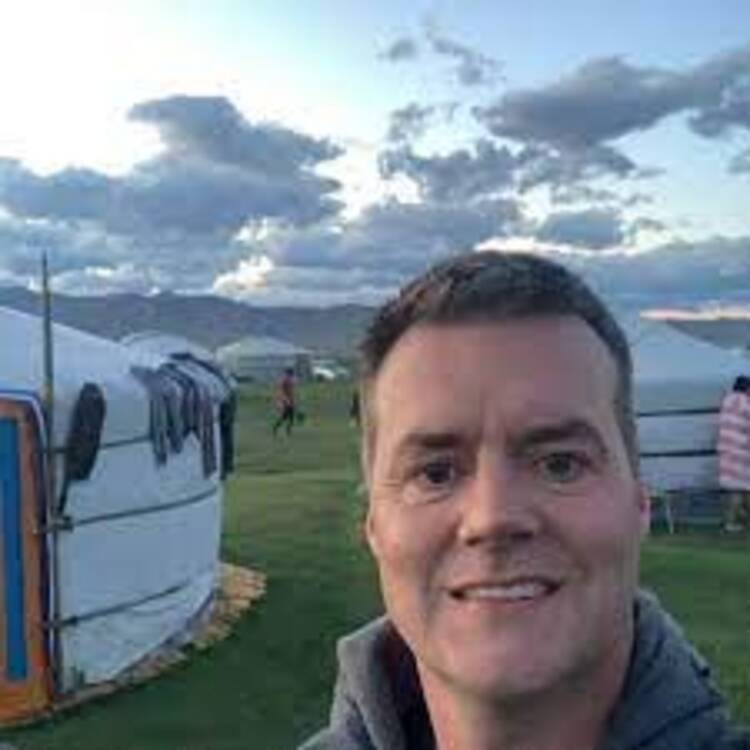After suffering the effects of longer than hopped for COVID, Rich thought he would listen to local advice and visit a former Soviet health spa located in the middle of nowhere in central Mongolia.
Shargaljuut, Health Spa - A Journey to Nowhere.
Introduction
Like many people in the world, I have suffered from the dreaded COVID, first Delta, then Omicron and the next, whatever fancy name was attributed to this terrible virus. But being one of the lucky ones, I have pulled through, although with a few unwanted long-term effects, loss of taste, painful headaches and some joint pains being the worst for me. Living and working in Mongolia and Central Asia has some highs and lows, and as I approached the dreaded Mongolian winter, friends and family thought it would be a good idea to head out to one of the former Soviet health spas to prepare for this year's sub-zero temperatures.
At first, I wasn't keen on the idea but having visited the Khoja Obi Garm in Tajikistan and being quite a fan of this most bizarre place, I thought, why not? If it works, I'll finally be able to taste a fizzy drink without it tasting like rust, and if not well, I will have had an adventure and a bit of content for this post.
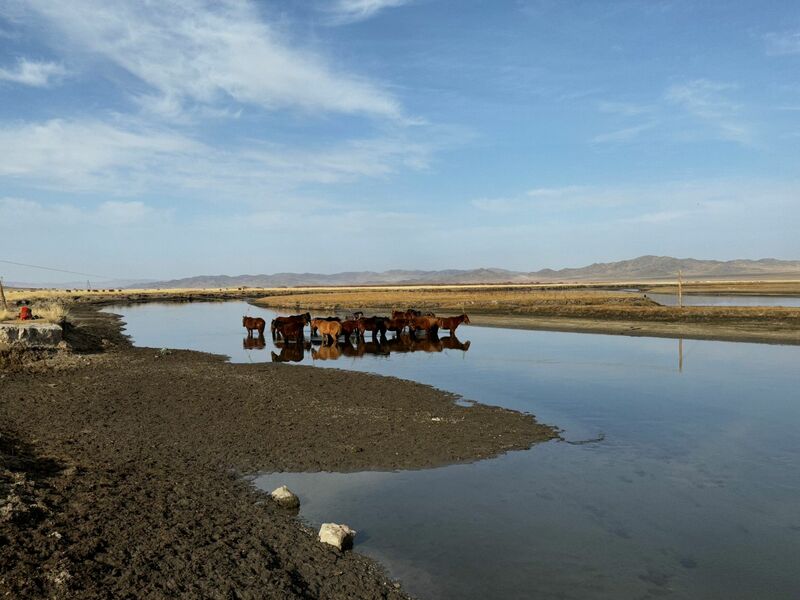
Why
Before we get to the actual adventure and some of the odd treatments I received, you may be asking why are/were Soviet health spas a big thing. Well, that dates back to when the Soviet Union was in its infancy, and Lenin was trying to promote a better working environment, spur on the masses, and improve productivity while paying everyone the same wage.
In the year 1920, Lenin issued a decree "On Utilising the Crimea for the Medical Treatment of Working People." This decree was then later ratified and expanded on in the Soviet Union's 2nd labour code of 1922 (the first being 1918). It was decided that mandatory vacations would improve a worker's outlook and productivity. This ruling was enacted across the Soviet Union, meaning that Sanatoriums were constructed at a rapid pace. Construction of various types of sanatoriums was to continue until the late 1980s and the demise of the Union.
The Soviet Union collapsed, but the spas continued, and now I find myself in another trusty truck about to leave the comfort of Ulaanbaatar.

The Journey
It's a wintery Saturday morning, and the clouds are heavy with snow, confirming the snow warning given on the weather reports. I can motivate and get a tour group of 15 out of a hotel and up a mountain perfectly on time, but when it comes to my own family, there is no chance! I plan to leave at 8 AM, but that comes and goes, and we eventually depart at 10 AM. It may seem odd, but many Mongolians travel vast distances with their kids, and we're no different! Drawing books packed, barbie has more spare clothes than me, and we are away. As I have written before, our first challenge is to break through the Ulaanbaatar city limits.
Traffic is relatively heavy but not as crazy as it can be; I leave the city with that odd feeling that in the melee of getting two kids out of the door into a 4X4 prepared for a 1000 KM round trip, I may have forgotten something!
One of the essential considerations when driving in Mongolia is fuel; I am taking the southern route to the health spa, which I have written about before. There are plenty of places to refuel, and the route is relatively busy (for Mongolia). But it's winter, and one should always be ready for an impromptu fuel blockade or other emergencies.
As I continue the journey out of the capital, the snow seems to get heavier. As the temperature here in the winter is incredibly cold, the snow doesn't melt on impact with the car. Instead, it becomes sticky, creating a crispy blanket enveloping the entire vehicle - very romantic if I didn't need to see out the windscreen!
Although I've taken the southern route many times before, the journey is never tiring. Especially as it provides a chance to witness the stunningly beautiful landscape of Mongolia throughout all of its seasons, as the grass changes from the lush green of summer to the darker oranges and browns of autumn and finally, as it is now, framed by the first dusting of snow which signals the start of Mongolia's infamous winter.
As the journey continues, the more familiar creatures which populate Mongolia's countryside surrounding Ulaanbaatar, such as horses, goats, sheep, and cows, are slowly replaced by a more intriguing host of characters as I leave the low-lying capital region and head into Central Mongolia. Herds of yak roam the steppe, their tiny eyes peeking out from beneath their enormous woolly coats. Majestic eagles and hawks swooping through the sky, their feathers slowly turning white as they begin to take on their winter plumage, and the sinister sight of flocks of vultures circling above the road searching for unfortunate animals to scavenge on the ground below.
However, leaving later than planned means I'm losing the light. Travelling across the solitary Mongolian steppe in twilight brings a whole new atmosphere to the adventure. Perhaps the oddest thing I notice is the scores of tiny mice scampering across the road in front of me - as winter is approaching, these tiny rodents are searching for food to keep them going until spring. However, their route across the road means it isn't hard to spot the remains of those who weren't so lucky. No matter though, they'll soon become food for the dozen or so foxes which occasionally leer out of the darkness at the side of the road, or their eyes visible in the darkness for a second as they're caught in the headlights.
Eventually, the light disappears completely over the horizon, and the solitary journey across the steppe continues, the only light emanating from my headlights or the distant glow of sporadic ger camps as nomadic families across the steppe light their evening fires.
Finally, I reach the turn off the main road towards the health spa; although this certainly isn't the end of the adventure - without any signposts or even a real road to speak of, the last jaunt over the bumpy landscape is a challenging drive to make. Relying entirely on MapsMe and friends and family in Ulaanbaatar passing us directions over the phone, I finally arrive at the entrance road to the Shargaljuut Health Spa - my home for the next week.
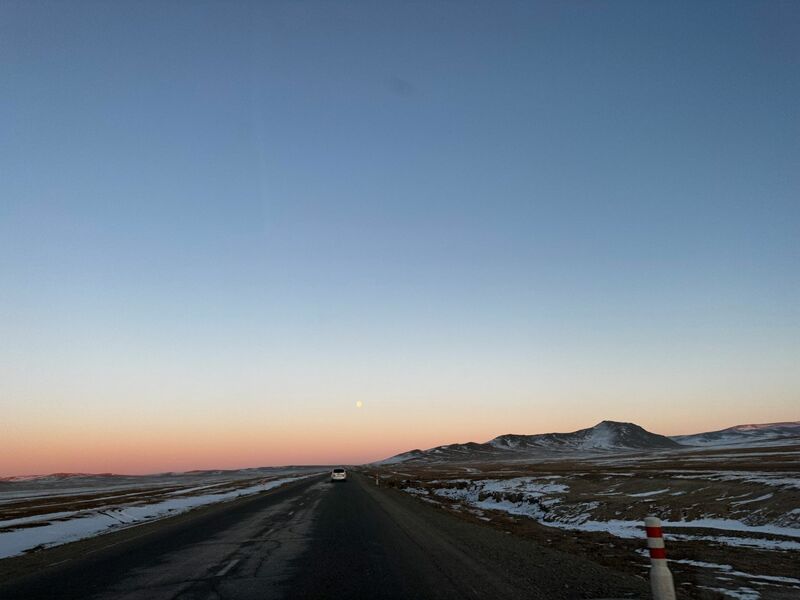
The Health Spa
As I approach, there's a seemingly out-of-place avenue of trees lining the road up to the sanatorium, perhaps this is because the Soviets used to import such trees all around their territories. I knew I had reached my destination when the distinctly soviet-style concrete buildings appeared on the horizon, along with some flashing neon signage - clearly a later addition!
I was expecting, given my late arrival, to be shown directly to my room. However, to my surprise, we were informed that as we had paid for that night, we were entitled to dinner. Led into a completely empty dining room, I sat down to enjoy my dinner of fried beef, vegetables, and some steamed rice; a welcome relief after all those hours of driving.
After dinner, I headed to my room and promptly passed out - my only waking thought; I wonder what the treatments will be like tomorrow.
The health spa is divided into a compound of different buildings. The main building is the hotel, also equipped with a restaurant. Nearby is the hospital building - in between the hospital and the hotel is the staff residence, older than the other buildings and seemingly not as well maintained as the other buildings. Although not as ramshackle as another series of concrete buildings further up the hillside - despite the semi-abandoned look of them from a distance, I'm told these are additional accommodations for the summer... glad I didn't come in the summer!
Other buildings included a smaller hut-like building with a neon sign, apparently a bar, although I never saw anybody inside. Individual chalets dotting the hillside, also additional accommodation, although apparently more for those visitors who want to come and enjoy the environment without partaking in any of the health spa treatments.
Most notably, our hillside overlooks another hillside which appears to be steaming. This is the intricate network of bubbling pools and hot water vents, which, due to the extreme temperature, results in a constant mass of steam rising from the ground and freezing as soon as it comes back into contact with the earth. Additionally, each vent and pool are numbered, supposedly to represent different parts of the body, and a visit to this wonder of nature is an important part of the treatment regime here and likely why the spa was built here in the first place!
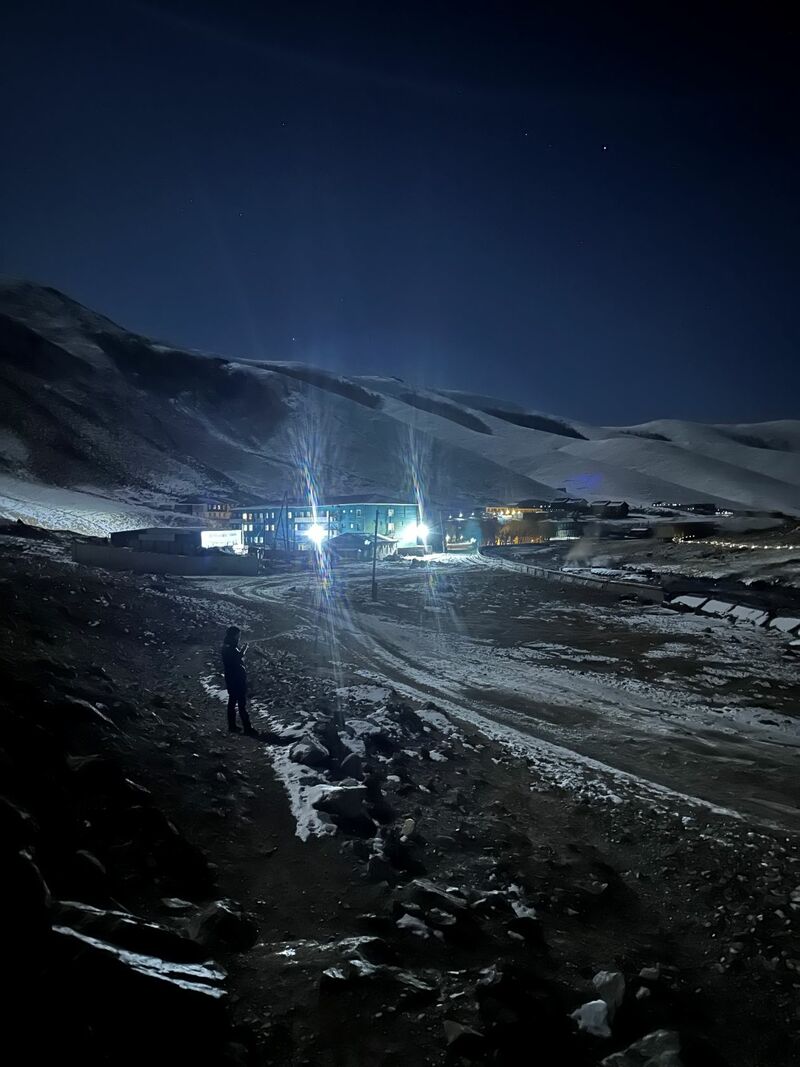
Consultation
The first thing every visitor must do upon arrival is check in at the main hospital for their consultation. I head over to the main hospital building, where I receive a small booklet to keep track of my various prescriptions and treatments. Following this, it's off to a visit with the doctor.
The doctor's role here is to provide a brief cursory checkup before prescribing a series of various treatments from around the sanatorium. From what I could understand from other visitors, most treatments are the same; what changes is how much one must do of each one. So, I went in to the doctor's office with a few typical complaints - fatigue, loss of smell, joint pain, and a light cough. As a result, I have prescribed the following treatments:
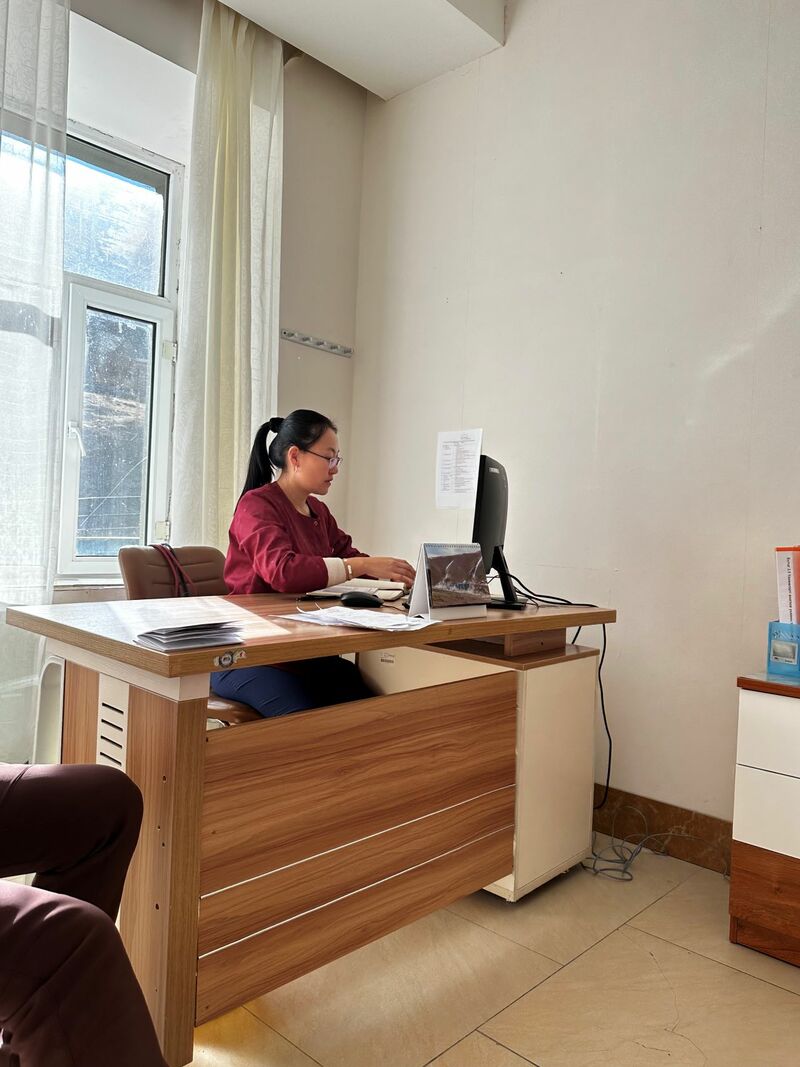
Massage
A seemingly fairly basic massage - certainly not the best I've ever had. Predominantly focused on my shoulders, back, and head. Most days, the practitioner was a woman, although on one particularly busy day, a man gave me my massage - he seemed not to like me too much because by the time I left, I felt like I'd been beaten up.
Cupping
For those unaware of this more traditional form of medicine, it involves the use of fire and jam jars! Despite this traditional history, it all seemed very hygienic - the practitioner wiped down every jar after use with alcohol rub, and the entire process felt very professional. Essentially, a ball of cotton wool is lit and held inside each jar to remove the oxygen and create a vacuum, at which point the fire is removed, and the jar is placed on a specific pressure point on the patient's back where the force of the vacuum sucks up the muscle into the pot. At its peak, I had 12 pots dotted all over my back. After 20 minutes of lying there, the pots are removed, resulting in huge bruised red rings on your back - although don't worry, it's believed that the worse the bruise, the more toxins have been removed. Although this is traditional medicine, every so often something would be placed in quite the right place and it would feel as though a nerve had moved or something generally positive had happened, so maybe don't write it off too quickly!
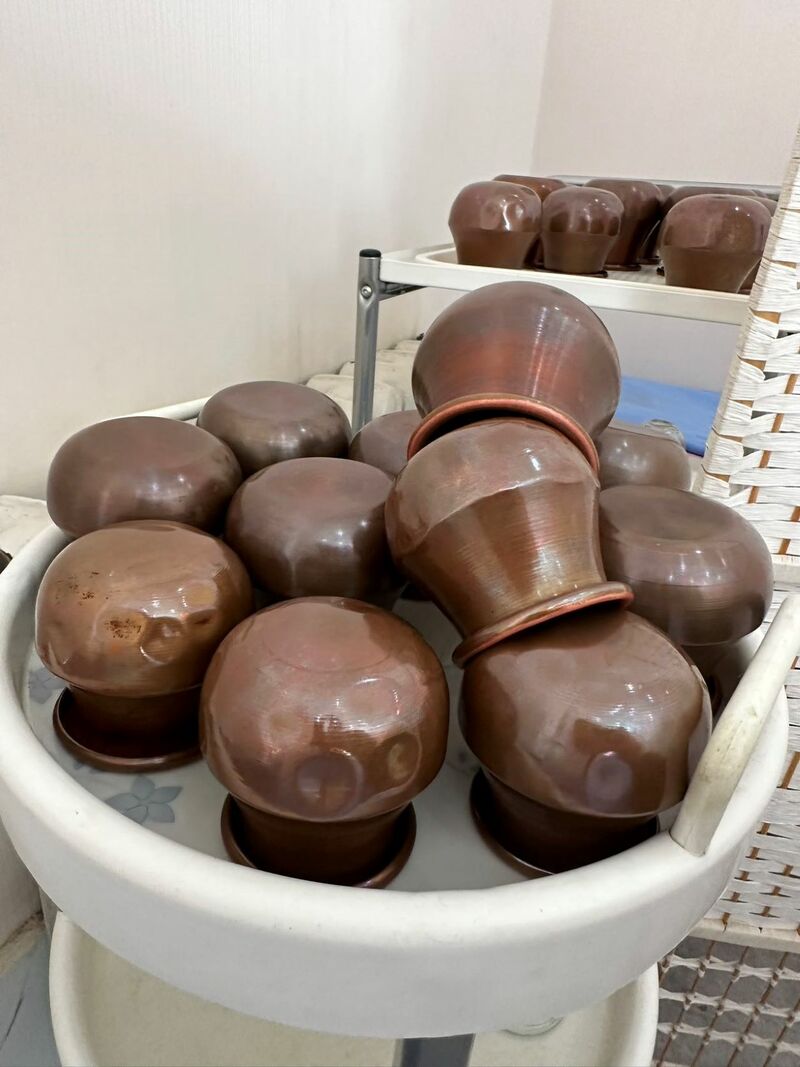
Electricity Treatment
Before you can begin your electrocution, you need to go and collect water from the aforementioned steaming hillside. Upon your return, they'll dip sponges in the water and place lead panels on top of each of them to ease the conduction of electricity. The electric machine itself looked about as old as the building, if not older! Certainly, a Soviet relic still being used. It felt like a minor current of electricity, not enough to make any huge difference other than a slightly annoying tingle. As to whether or not it improved my health? The jury's out!
Steam Room
A typical sauna-like steam room still popular across Russia and parts of Asia. Unlike all other steam rooms I've visited, this steam was pumped in from the steaming hillside and first passed through a bizarre Rube-Goldberg-Esque filtration system, which was a helpful distraction whilst trying not to look at anybody else naked accidentally. The room also had some neon lights added for good measure! Notably, the room smelled significantly of sulphur - a sign this steam truly had come straight out of the ground. As with all saunas, the major benefit is in opening up your skin and your pores which certainly had some benefits.
Bath Room
Cubicles with giant wooden baths filled with scalding hot water pumped down from the mountainside. Apparently, the water is rich in minerals, including Radon. Before going in you're handed an egg timer set to 10 minutes, after which you can head in to enjoy a naked, boiling hot mineral bath right up to your shoulders. If you were allowed in longer, it would be enjoyable to sit in the bath with a good book, however, any stay longer than 10 minutes is deemed potentially more harm than good, I left feeling invigorated nonetheless!
Mud Treatment
I came for a mud treatment four times, once each day. The mud used is from the local area, so it's oily and reeks of sulphur. Upon arrival, the practitioner would check my little book, which highlighted the areas where the mud would need to be applied. The mud was scalding hot and not especially pleasant. An additional struggle I needed to go through would be unlikely to cause issues for the average Mongolian. However, I'm 6ft 3in, and so the bed, which was blocked at each end, made it impossible to stretch out. So, lying at a slightly awkward angle being caked with boiling sulphurous mud didn't feel fantastic. Even less so when I was wrapped up in plastic sheeting with a blanket surrounding me for 20 minutes. After the lady returned to scrape the mud off, I had a quick shower to get rid of any traces of the mud before escaping. Did it work? I don't know - but it certainly didn't feel very enjoyable. The whole process seemed very over-the-top, although I did feel oddly rejuvenated afterwards; perhaps this was the treatment, or perhaps it was the feeling of escaping the mud coffin. All I would recommend is longer tables!

Mountainside Steam Treatment
During my consultation, the doctor specified which pools I would need to collect water from and how much I'd need to drink each day. Personally, I was recommended particular pools of water high in calcium to help joint pains.
In a different area, I was prescribed to sit for around 10 minutes in a specific area on some rocks, heated from beneath by the geothermal energy, with some fantastic views over the surrounding countryside and the austere Soviet health spa behind me.
On another occasion, I was told to go and collect water from a hole which was reminiscent of a small nostril to clean my nose with, an odd experience made worse by the extreme sulphurousness of the water. Intriguingly, the nose water hole was between the two ear water holes - it was perhaps here where the hardened science gave way to the more mystical element of the treatments.
Also on the mountainside was a natural spring from where we could collect natural drinking water.
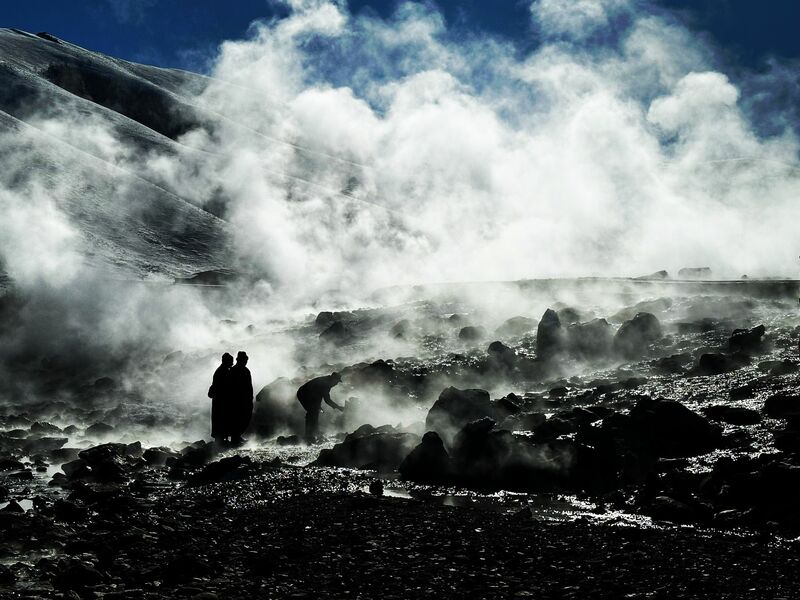
Steaming Box
I was told to visit this large wooden box built over a steam vent twice a day. The idea was to place your face in this box and breathe in the steam. Each day, the length of time would increase until I was spending a full 10 minutes inhaling the steam, eventually, it would decrease again to just over a couple of minutes. The steam box and steam inhalation is meant to improve lung health, and it really did feel like it helped clear my airways, the hike up and down the mountain to the box was probably also helpful in this regard. Walking around during the night time amidst the concrete buildings of a Soviet health spa was also a cool, albeit eerie feeling!
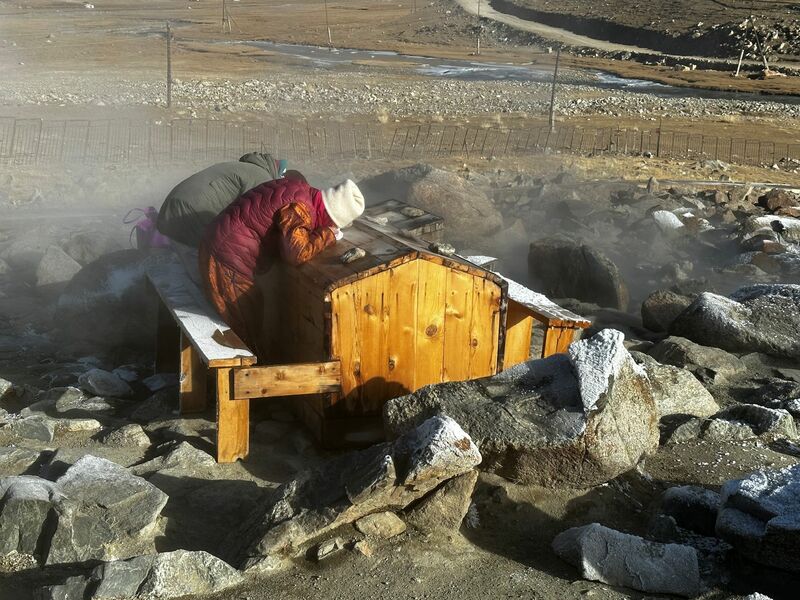
Conclusion
The health spa was a truly interesting and intriguing experience. On top of the variety of weird and wonderful treatments, Soviet architecture, and questionable medical practices, half way through our stay the clouds opened with an immense snowfall, adding to the unique and wonderous atmosphere surrounding us, along with increasing concern and worry about the return drive!
Do I think it worked? I feel like the escape from the city, and the fresh mountain air certainly had some benefit, along with those specific treatments based more in proven science. However, some of the other treatments were based more in tradition than science and maybe had less of a physiological impact than was advertised, although they certainly didn't do any harm and aided my general feeling of relaxation.
That said, whilst staying at the health spa, I did pick up a rather nasty cold! Upon my return to the city, the hamburger I'd been craving all week was a welcome return to civilisation.
